Choosing An Air Compressor
It Can Be a Very Useful Project Tool, So Understand Your Options Before You Buy One.
I WORK AS A compressed air energy auditor and sales engineer. I spend my days in industrial plants collecting power, pressure and flow data for energy analysis reports. The local power companies offer cash incentives to upgrade systems with newer technology, mainly VFD (variable frequency drive) compressors. Many of these projects pay for themselves in under two years and the benefits continue long after.
Why use compressed air in the first place? The reasons are many. When compressed air leaks, it doesn’t leave a slimy mess like hydraulics, or pose the shock hazards of electric tools. The tools you can use are generally less expensive, can be rebuilt, have adjustable torque and rpm, have less moving parts, and don’t require rechargeable batteries or small electric motors.
Every so often, a home owner stops by our shop looking to upgrade his personal shop. Usually, the guy is trying to run some bigger air tools and his little compressor just can’t keep up, or it burned up completely. A lot of our repeat customers have started with a 5 hp compressor for their hobby-shop garage then moved up to the industrial level screw machines when they decided to open a full scale business. Here are the main points to discuss while upgrading a home shop.
The first question we ask is, “What are you planning on doing? Are you setting up a bead-blast cabinet? How often are you going to use it?” You probably need a 2 hp compressor on a 30 gallon tank if it’s seldom, but a 3–5 hp if you run it all day on the weekends. Painting a high-end vehicle? You also need an air dryer and a bigger receiver tank. Removing rust with a scaling hammer on a few parts or a whole frame? Each of these answers will help you set up the best system.
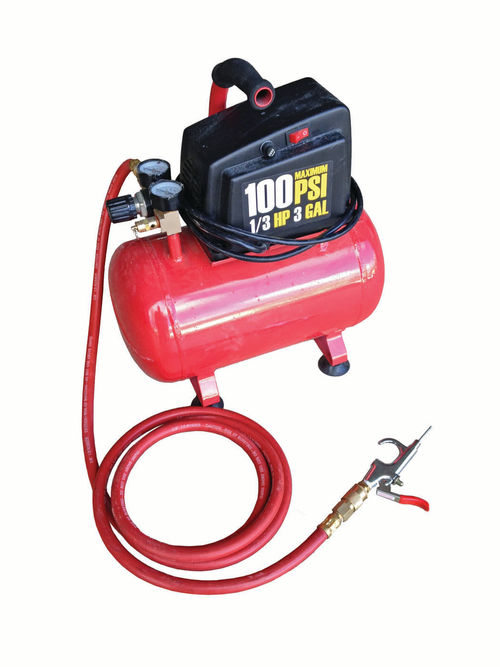
Compressor Types
Reciprocating, “recip” or piston compressor: Recip compressors range from the little 12-Volt compact one I carry with me, up to about 20 hp, capable of running a decent-sized auto shop. These compressors have pistons similar to gas engines with either one or two stages of compression. Two stages can typically reach higher pressure, last longer and cost more.
Screw Compressor: These compressors have two mated, helical screws like a supercharger. They range in size from 10 hp to 350 hp and are meant to run all day long, fully loaded. Tire shops, professional sand-blasters and paint shops typically use screw compressors.

Both screw and reciprocating compressors need oil for the bearings, gears and/or crankshafts. The most common are referred to as Oil-lube or lubricant injected. The compression chambers are injected with lubricant (oil) for sealing and to remove the heat of compression. As a result, they have lower discharge air temperatures, better volumetric efficiency, last longer and require more maintenance.
The other type of compressors have “dry” compression chambers with tighter clearances or dry rings know as “oil-less” or “oil free.” No oil is used in the compression chamber. This produces cleaner compressed air but has the drawbacks of higher output air temperatures, higher noise, lower efficiency and faster wear due to lack of lubrication of the rings or non-contacting, gear-driven screws.
Drive Types
Gear: These use a gear set to speed up the screws in order to push more CFM through the machine. Higher speeds can cause higher wear and more noise.
Belt: The use of belts and pulleys allows for some adjustability of capacity but the belts are a maintenance item along with their alignment.
Direct drive: This is the most efficient power transmission method, but you’re stuck with motor speed of 1800 or 3600 rpm. Slower drive speeds are usually preferred for longevity and noise levels.
Control Modes
Stop/Start: Most reciprocating compressors run this way. A switch turns the compressor on when the pressure gets to a setpoint, for instance 120 psi. The compressor runs until it gets to, say, 150 psi, then turns off. The amount of time it runs depends on the usage, the pressure differential and size of the receiver tank.
Load/Unload: This control mode is used when frequent stops/starts are unwanted or causing too many starts on a motor. The compressor has a valve that closes the inlet to the compressor and relieves the pressure on the compression chamber, effectively taking the compressor out of gear and running it in neutral. The pressure is maintained in the system with a check valve.
Modulation: This control mode has been used in screw compressors since their invention. A valve on the inlet of the screws throttles the amount of air entering the compression chamber. This method is quite reliable and maintains steady outlet pressure over a wide variety of demands, but it is inefficient at low demands.
VFD: Variable Frequency Drive. This is a motor controller that uses an inverter to change the rpm of the motor to match the air usage and maintain stable pressure. These are a hot topic in compressed air these days, and many power companies currently offer energy incentives to offset the higher costs of the VFD compressors. VFDs aren’t normally applied to compressors smaller than 25 hp.

Noise
All compressors make noise. To have a quieter compressor, it needs to run slowly (preferably less than 1800 rpm) or have a sound enclosure. Sound ratings can be misleading. It’s best to listen to a buddy’s compressor or ask your sales guy to let you listen to one running. Some have a pleasant thump and others have a strained, high pitched whine. If you go with an enclosure, its venting needs to be sufficient to remove the heat but also allow access for maintenance and repairs. Modern compact design has crept into the compressor world and there are some models that look like they have 5 lbs. of “stuff” in a 1 lb. box. If you don’t have the space to put the compressor away from sensitive ears, go with an enclosed model, just make sure you have access to get the doors off for maintenance.
Heat
All compressors generate heat. About 85% of the energy consumed by an air compressor gets turned into heat. If your shop is cold, your compressor can help keep it warm. If it’s hot, putting it in the back closet is a bad idea. Most industrial users have special compressor rooms in the back of the factory with filtered inlet air from outside and a powerful ventilation system. If you put it outside, be careful it’s not in direct sunlight, rain or freezing conditions. Blowing dust or cotton wood fluff can clog up the radiators and cause overheating problems.
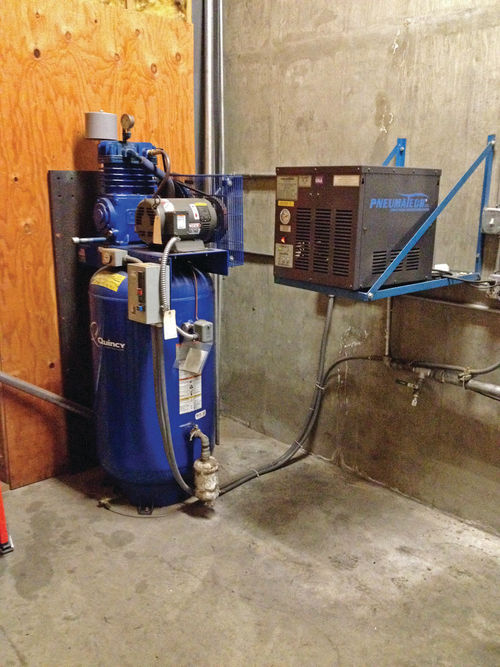
Dryers
Dryers are probably the most overlooked item when you make the jump to a shop-sized air compressor. If your blow-off gun sprays like a garden hose when you first pull the trigger, or your grinder is blowing water from the exhaust port, you need a dryer. Wet compressed air is the cause of many fisheyes in paint jobs, clogged media blaster nozzles and frozen sanders. A good dryer can cost about half as much as your compressor. That can be a tough pill to swallow, but the air quality is worth it.
The two main dryer types are “refrigerated” and “desiccant.” A refrigerated dryer has a refrigeration compressor and a heat exchanger to cool the air, condense the water, remove it, then heat the air back up to the system. Refrigerated dryers come in two types which include “cycling” and “non-cycling.” A non-cycling dryer runs all the time and is the least expensive option. They run like a pressure washer with a bypass valve. A cycling dryer runs like your home refrigerator. It cycles on to cool a secondary cooling fluid, then shuts off while the cooled fluid does the work of drying the air. Both of these dryers are the industry standard for most users and operate at a 38° F dewpoint. Dewpoint is defined as the temperature when the water in the air lines will condense. With a properly sized and maintained refrigerated dryer in an indoor environment, water in the air lines and tools will not be a problem. It should also be noted, when using a refrigerated dryer with a reciprocating compressor, there needs to be an aftercooler on the compressor or built into the dryer. A reciprocating compressor without an aftercooler can discharge 200°+ F air. Refrigerated dryers work best when the air coming into them is 100° F or less.
The second type of dryer is a “desiccant” dryer. These dry the air to a -40° F dewpoint or better. They’re about twice the cost compared to refrigerated dryers. However, they provide very dry air, perfect in high- end painting and laser cutting applications where any moisture is detrimental.
Even if you don’t buy a dryer, a filter is a good investment. It can drop out some of the moisture, and most of the oil and particulate matter from the air stream. It will protect your tools and paint jobs from contamination. For home compressors, the extra $50 for a 3 ⁄8” combination filter/ regulator is money well spent. Just make sure you drain it and change the filter once in a while.
Power
Above about 2 hp, you can’t just plug your compressor into a standard single phase, 15 Amp, 120 V wall outlet. From 3 hp to about 7.5 hp, you’ll be in the single phase, 220 V range—akin to what you’d need for an electric clothes dryer or kitchen range. Once you get to 7.5 hp and up, it’s time to play with the big boys and get a three-phase service. Then you can add that heavy duty welder or run that end mill you’ve always wanted. Three phase service comes mostly in 240 V. For 50 hp and up, three-phase, 460 V is the standard.
Piping
Whether to put in hard pipe in your garage is another of those application questions we’re often asked. If you typically roll the compressor out to plug it in, it doesn’t make sense to have a bunch of hard pipe. But if the compressor is at the far end of your garage and you get tired tripping over your hoses all day and recoiling them every night, it’s time to put in some permanent pipe and hose reels. Don’t just loop the rubber hose over the rafters. The bends break down after awhile and start to leak, robbing you of precious CFM. A long hose also causes a surprising amount of pressure drop. And, beware, when an old, long rubber hose breaks, it can turn into a pressurized whip with surprising force. And if you are gone for days when a hose breaks, your compressor may run non-stop and burn out the motor before you return. It’s better to get some hard pipe and run it where you need it most with ball valves in front of quick connects and have a drip leg at both ends with a petcock valve to drain out any condensation.
Never use PVC for hard air lines. Yes, it’s cheap and easy and says 150 psi rated; however, after time, the PVC can sag. If you bump it with anything, it can break. The hot temperatures of compressed air will break it down as will the compressor oils. And when PVC breaks, it can shatter, sending plastic shards everywhere.
Galvanized or black iron pipe is good if you have a threader to get the lengths right. Sweating copper tubing can make for a really nice installation. There also are aluminum piping systems available. They require expensive fittings, but the installation is quick and easy. You just cut the pipe to length, push the ends in the fitting and tighten them with a spanner wrench. It’s so easy to take apart and set up, you could take it with you when you move into a bigger shop.
It’s not really necessary to have downhill runs in your air lines, like you would for plumbing pipe. The air flow will keep any moisture or particulates moving through the system.
Maintenance and Repairs
All compressors need regular oil changes, and most of them also have oil filters, air filters and other items. Before you buy, make sure to check on the amount of parts you’ll need and the intervals in which you’ll have to change them.
Many compressor companies require you to use their OEM filters and oil to maintain warranties. Some OEM oil is very expensive. If you go off-brand, just remember, not all oils and filters are created equal. Just because an auto parts store spin-on filter fits, it does not mean it’s meant to handle the pressure and filtration requirements of an air compressor. If you plan on having factory service, get a quote and read the fine print on maintenance contracts claiming to extend warranties. Some things aren’t covered after certain amounts of time.
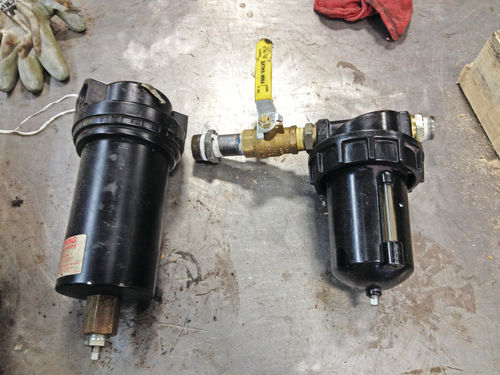
Application
Reciprocating compressors are best for intermittent applications, meaning the demands aren’t constant. Fill a tire, run the lift, bead blast a couple parts. These compressors are meant for, at most, a 50% duty cycle, meaning it should run for a few minutes, then be off for a few minutes. Some manufacturers will say a 100% duty cycle, and it will…until it burns up. If your recip compressor is running more than it’s not running, it’s undersized and won’t last.
Once you start running grinders, sanders, serious media blasting or paint guns a lot of the time, upgrading to a screw compressor is a good option. They are meant to run continuously. On the converse side, if your screw compressor is over-sized, it can be just as bad. Frequent short cycling is bad for the components. On any compressor with an oil sump, if it doesn’t run enough to get heated up, water can build up in the oil and cause problems. Relieve the pressure when you’re done using it and always check the oil before you start it up. Some suppliers make screw compressors down as low as 5 hp, but 15 hp is the usual starting point. The very small models get so compact and are so “value-engineered” to keep costs down that their reliability suffers severely.
Most auto garages run a 5–10 hp reciprocating compressor with a 120 gallon tank and a dryer. This size can keep up with a few garage bays, with techs running air tools as needed. For a home mechanic working on the weekends, a 3 hp compressor on a 30–60 gallon tank will keep you happy for years. Just make sure to keep the tank drained and check the oil every time you use it.
If you have the space, don’t skimp on the receiver tank. Receiver tanks help keep the stops and starts down. The bigger the tank, the better. It’s basically a shock absorber for the system. Tanks are generally the cheapest, lowest maintenance item in a compressed air system, but, unfortunately, the most under-purchased. A bigger tank can let you do four minutes of bead blasting instead of two before the pressure drops too low and you have to wait until the tank is refilled.
What Are the Best Brands?
The compressor market has become saturated with foreign and domestic competitors, and competition is fierce; you pretty much get what you paid for. The big players are Quincy, Ingersoll Rand, Champion, Gardener Denver, FSCurtis and others. They all have different levels of sophistication, performance and quality. Good questions to ask are: Where do you send it for warranty? Will they come out to you, or do you have to ship it back across the country on your own dime, or can you return it where you bought it? Are there locally stocked parts and service shops with technicians in your area to support your purchase?
We can’t really have a home air compressor conversation without considering the very affordable options available at Harbor Freight, Northern Tool and others. Their replacement warranties can be pretty good if you pop for the extra cost. Harbor Freight even has a nice sizing diagram on their website suggesting good hp and tank sizes based on the types of tools used. I’d recommend the higher-end models with cast iron construction, oil lubrication and an 1800 rpm motor. On any budget branded compressor, the motor is usually the weak link. How much you run it and how often plays a large part. If you’re in the garage every night and all weekend, you’ll obviously burn it up quicker than a twice-monthly kind of home mechanic. If it does break down, the chances of finding repair parts for budget compressors are slim. A good indicator of quality is how much it weighs. The hp-to-weight ratio is inverse here. More steel is better. There are also different types of oil lubrication in the reciprocating market. The less expensive models use splash lubrication consisting of an oil slinger in the crankcase to splash the oil around, and they’ll also use reed valves to seal the compression chambers. The higher end models use pressure lubrication. There’s an oil pump to deliver oil to the critical areas. These are the industrial grade machines. They are completely rebuildable and can last many years and usually have poppet intake valves made to seal better and last longer. Finding one of these at an estate sale or auction would be pure gold.
If you’re in the market for a used compressor, make sure the model is still in current production. Many factories build compressors with proprietary parts and once a model has been discontinued they only support the machine for the amount of time required by law (seven years).
Most compressor shops will test a used compressor for you and give it a quick onceover for a couple hours of shop time.
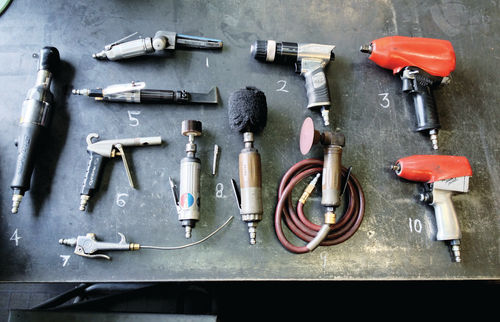
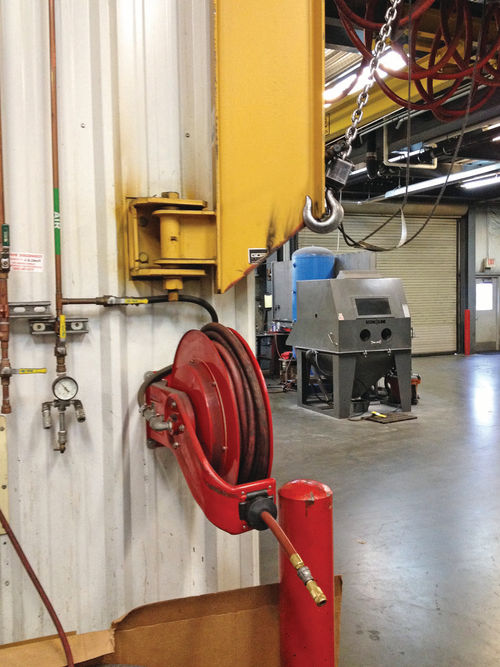
Air Tools
Once you have a nice compressor setup, there are many handy tools available that can both speed up your work and greatly reduce the manual effort required. Check with the manufacturer’s ratings to make sure your compressor has enough capacity for the jobs you are contemplating. However, there’s always the usage factor. If you only pull the trigger for 10 seconds, that’s 1 ⁄6 of the rated CFM being consumed. The size of your receiver will also allow you more time for longer trigger pulls.
Safety
Despite all the benefits of compressed air there are some safety issues. Compressed air from a shop compressor should never be used for breathing. There are special requirements and regulations concerning breathing air. Also, never use compressed air to blow off exposed skin. If you have a cut and an air bubble gets in your blood stream, it could be very dangerous. Also, take care when blowing off parts; debris can easily get blown back at you, causing cuts or get in your eyes. Always wear your safety glasses. Finally, when hooking up 220 V or higher power, make sure to use a qualified electrician.
Bottom Line
An air compressor can be a great addition to your shop. The function and versatility of the tools available will make doing your own restoration and maintenance projects even more enjoyable.
Resource
CAGI:Compressed Air and Gas Institute Cleveland, Ohio cagi.org
This is a great information source with highly-detailed free application guides.
Definitions
CFM: Cubic feet per minute—the volume of air the compressor actually compresses usually associated with a pressure rating. Tools also have a pressure and CFM rating to match the compressor-usage factor.
Usage Factor: The usage factor takes into account the time when the tool is not running, allowing the receiver to recharge. An air impact is a good example. It might consume 10 CFM while it’s running, but it only takes 15 seconds to put on a lug nut, effectively making it 2.5 CFM on average. Most design specs use somewhere from 15% to 35% usage factor. But if you’re running a paint gun all day long, the usage factor could be much higher.
PSI: Pounds per square inch. Most tools need the compressed air to be regulated to 100 psi or less to run properly.
HP: Horsepower, we all know what that is.
SCFM & ACFM: SCFM is Standard cubic feet per minute and ACFM is Actual cubic feet per minute. ACFM is corrected for temperature, humidity and elevation. For instance, in Denver, where the air is thinner, 1.0 SCFM is about 1.2 ACFM. Tools are also rated in SCFM so you’d need about a 20% larger compressor to run the same tools in Denver as at sea level.
Advertised Power: Some compressor companies play little tricks with “displacement,” and “delivered” CFM. The displacement of the compressor does not take into account the internal compression losses as the pressure rises. A compressor in a store showed a compressor rated 15cfm @ 90 psi and 16cfm @ 40 psi. The moral of the story is to read the fine print and make sure you’re getting the CFM at the pressure you need.
Dewpoint: Dewpoint is the temperature at which you’ll start to have condensation in your pipes, tanks and tools. When it’s hot and humid, ambient air is holding more moisture and when the air is compressed, the moisture condenses into liquid. An air dryer removes this moisture.
















